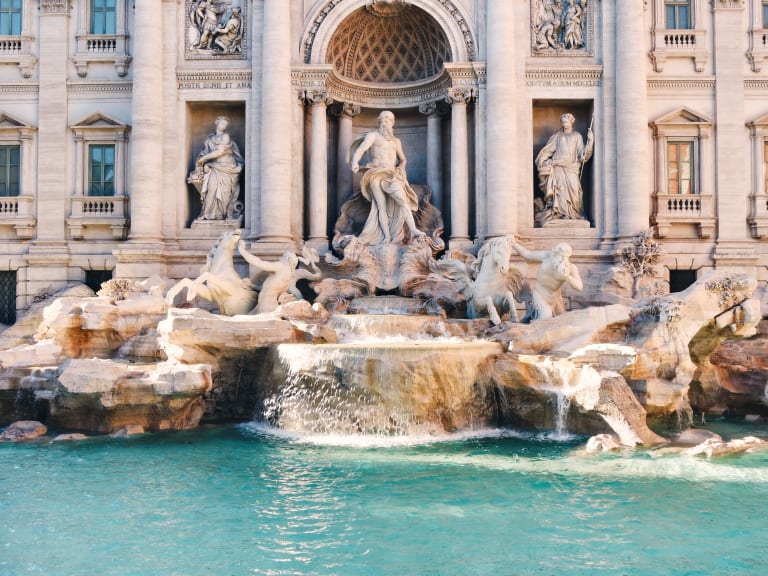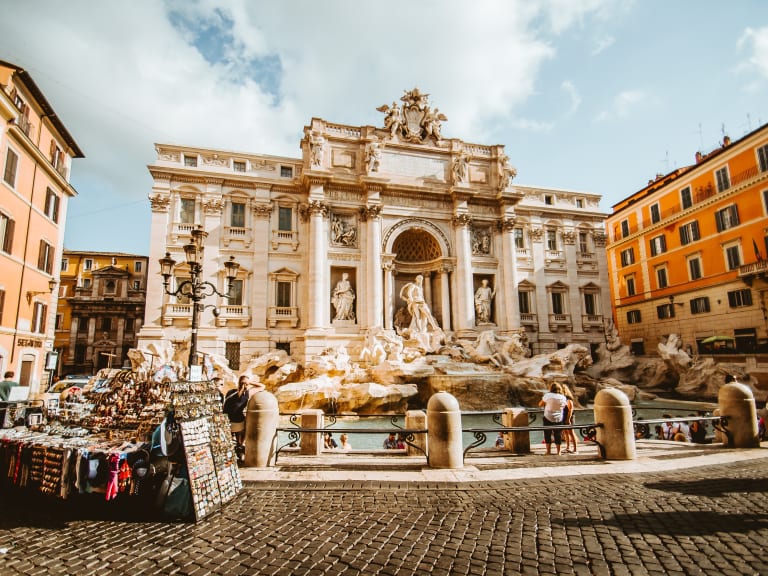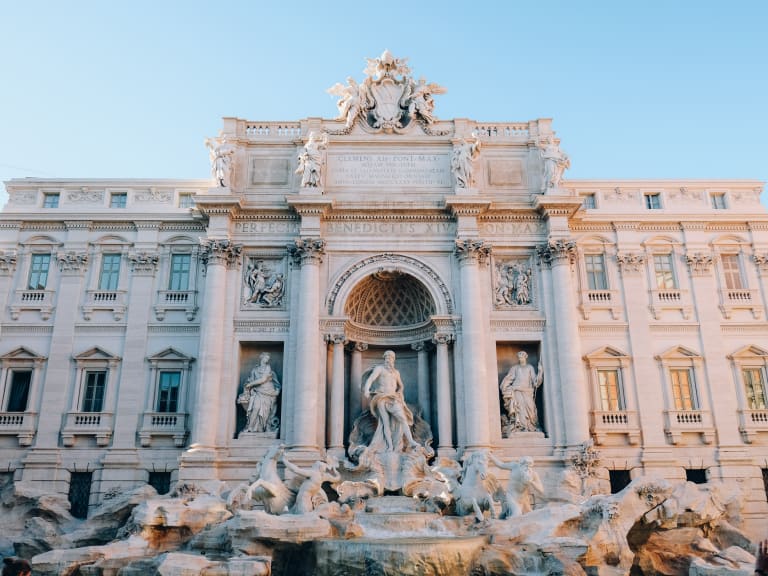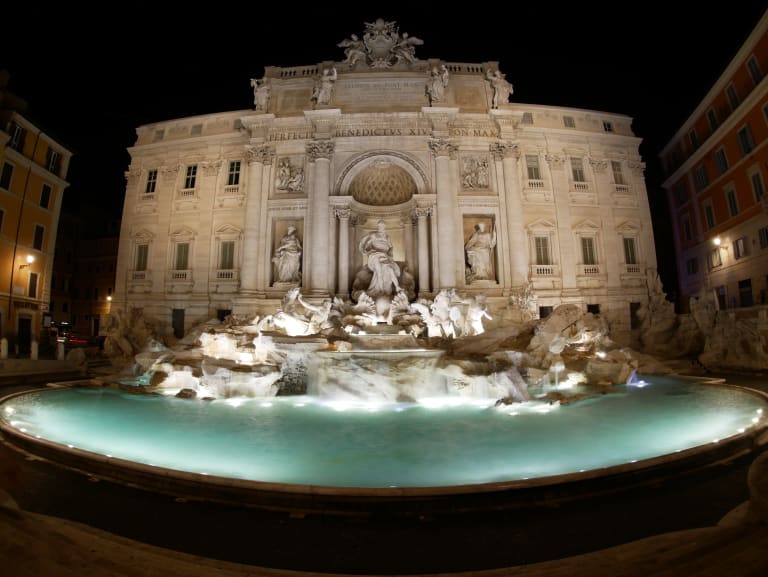More about: Everything You Need to Know About the Trevi Fountain in Rome: History, Legends & Tips
No trip to Rome would be complete without a visit to the most beautiful fountain in the world, the Trevi Fountain. Both for its allegorical beauty and its historical significance, it is well worth spending some time admiring it.
As it is one of the most visited places in Rome and probably one of the attractions where it is easiest for the experience to be less than perfect, I have written this guide with everything you need to know before visiting the famous Trevi Fountain: its history, its artistic significance and, most importantly, a series of tips to help you enjoy it to the fullest.
When and how to visit the Trevi Fountain: tips and advice

Twice as good as once
Visit it twice, once during the day and once at night. At dawn, there won't be many tourists and you can enjoy the fountain in all its splendour, and after midnight the place will have a special aura with the beautiful lighting of the Trevi Fountain.
How to avoid mass tourism
Whatever you do, don't visit the fountain at 1 p.m. or at the end of the day, as you'll find yourself in a swarm of tourists who will probably ruin your experience.
Watch out for pickpockets
Of all the places in Rome, here it is especially important to keep an eye on your bag, backpack or wallet. As it is such a small space and attracts many unsuspecting tourists, as soon as there is a crowd, pickpockets will be on the prowl. Pay attention to your surroundings at all times and especially to your belongings so that you don't get robbed.
Don't fall into tourist traps
Also be wary of people who offer to take your photo at the fountain, as they will want to charge you for it afterwards and can be very persistent if you refuse.
Better not try to 'go in' the water (and you've been warned)
It probably goes without saying, but you can't swim in the Trevi Fountain like in the iconic scene from 'La dolce vita'. Well, you can if you want to, and take a photo if you like, but the 'entrance fee' is a €500 fine. If you're thinking of taking the risk, do it right: it's best to do it in the early hours of the morning, when the fountain is at its most beautiful and there are fewer tourists and police around.
Where is the Trevi Fountain and how to get there

The Trevi Fountain is located in the square of the same name, which can be reached from several nearby streets: Via del Corso, Via del Tritone and Via della Dataria.
The nearest metro station is Piazza Barberini. From here, head west along Via del Tritone until you reach Via della Stamperia, and down the street you will arrive at Piazza di Trevi, one of the most beautiful squares in Rome.
All about the tradition of throwing coins

Travelling is one of the best ways to discover the little customs and traditions of places around the world, and the tradition of throwing coins into the Trevi Fountain is one of my favourites of all the places I have visited. There is no better occasion to quote the famous proverb of Saint Augustine that led to the well-known Anglo-Saxon saying, 'When in Rome, do as the Romans do '.
How to do it
Custom has it that you should stand with your back to the fountain and, with your right hand, throw a coin over your left shoulder. This will ensure that you return to Rome at some point in your life. But if you throw a second coin, legend has it that you will find love (or fall in love with an Italian, depending on the version), and with a third coin, you will ensure marriage or divorce.
The origin of this tradition
Butwhere does this tradition come from? I imagined it would be an ancient legend, originating from some pagan superstition, but no: people started throwing coins after the release of the film Three Coins in the Fountain in 1954, which defined the tradition with all its peculiarities.
What do they do with the money collected?
Logically, given how popular the tradition of throwing coins into the Trevi Fountain is, a lot of money ends up at the bottom. Around 3,000 euros are collected from the fountain every night, which are donated to Caritas, a Catholic charity that provides services to needy families in Rome.
What to see near the Trevi Fountain

The Trevi Fountain is an ideal place to visit as part of a tour of Rome, as it is on the way to many of the main attractions in the city centre.
Here are some tourist attractions in Rome that you can take advantage of seeing on the same day as a visit to the Trevi Fountain:
Piazza di Spagna
With its famous set of steps and beautiful Fontana della Barcaccia fountain, the Piazza di Spagna is a very pleasant place to visit, especially in spring and summer when the steps are covered with floral decorations.
Barberini Square
Home to the Fontana del Tritone, one of the most beautiful fountains in Rome, and the Barberini Palace, which is of great historical importance as it was the residence of Pope Urban VIII. It is well worth a visit and a stroll around the surrounding area.
The Pantheon
This building is the best preserved in Ancient Rome and is a spectacular sight both inside and out. A free visit that you must include in your list of things to do on your trip to Rome.
Piazza Navona
Piazza Navona is one of the most important squares in Rome, where you can see three beautiful fountains and visit the church of Sant'Agnese in Agone. There are plenty of restaurants and cafés in the area, which is always lively with street artists and a constant stream of tourists and locals.
A little history about the fountain

The architecture of the Roman Empire always had the maxim of being useful to the citizens. The fountains of the city of Rome had the function of indicating a place where drinking water could be obtained for drinking, cooking and cleaning, but in the case of the Trevi Fountain, like other fountains built during the Baroque period in Rome, these monuments also acquired the function of worshipping water and enhancing its symbolism of purity and renewal.
That is why the fountain that stood on the site of the Trevi Fountain was renovated in 1629 at the behest of Pope Urban VIII, becoming the marvellous work of art that we can admire today.
The pope entrusted the commission to the artist Gian Lorenzo Bernini, under his patronage, and he began his original design; however, the project was abandoned upon the pope's death and it was not until 1730, a century later, that Pope Clement XII chose the architect Nicola Salvi to complete the famous fountain. Incidentally, the name Fontana di Trevi comes from its location at a crossroads of "three roads", something you can see for yourself when you visit.
What does the Trevi Fountain represent?

The Trevi Fountain is a wonderful work of art that is not part of a museum exhibition, nor is it part of a monarch's private collection, nor is it kept in a church. What makes it so special is that it stands in the middle of the city, ready to be admired by anyone who passes by, and if you visit it with an expert on a guided tour of Rome, you can discover all the secrets hidden in its sculptures.
The artists
Begun by Gian Lorenzo Bernini, the great architect and sculptor to whom Rome owes much of its beauty, and completed by Nicola Salvi, the Trevi Fountain is an allegory of the taming of the sea, with a series of symbols and allegories hidden in its various sculptures.
Its symbols
In the centre of the fountain, in the main niche, stands the statue of Oceanus, the god of the sea, on a chariot pulled by two sea horses, one agitated and the other calm, representing the two states of the sea.
To the left of Oceanus stands the statue of Abundance, holding a cornucopia and above which is a relief depicting General Agrippa ordering the construction of the Acqua Virgo aqueduct, which brought water to this fountain. According to legend, the name of the aqueduct comes from a maiden who showed Agrippa the location of the spring on which the Trevi Fountain now stands.
To the right of the fountain, the statue of Health (or well-being) holds a cup from which a snake drinks, the Cup of Hygieia, a traditional symbol of pharmacy.
Crowning the Trevi Fountain are four statues representing the beneficial effects of water on the Earth, symbolising abundance, fertility, the grape harvest and wine, and the beauty of Nature.
Something that many people don't realise is that the grandeur of the fountain is due to the façade of the Palazzo Poli, which provides a spectacular backdrop to the elements that make up the fountain itself.














